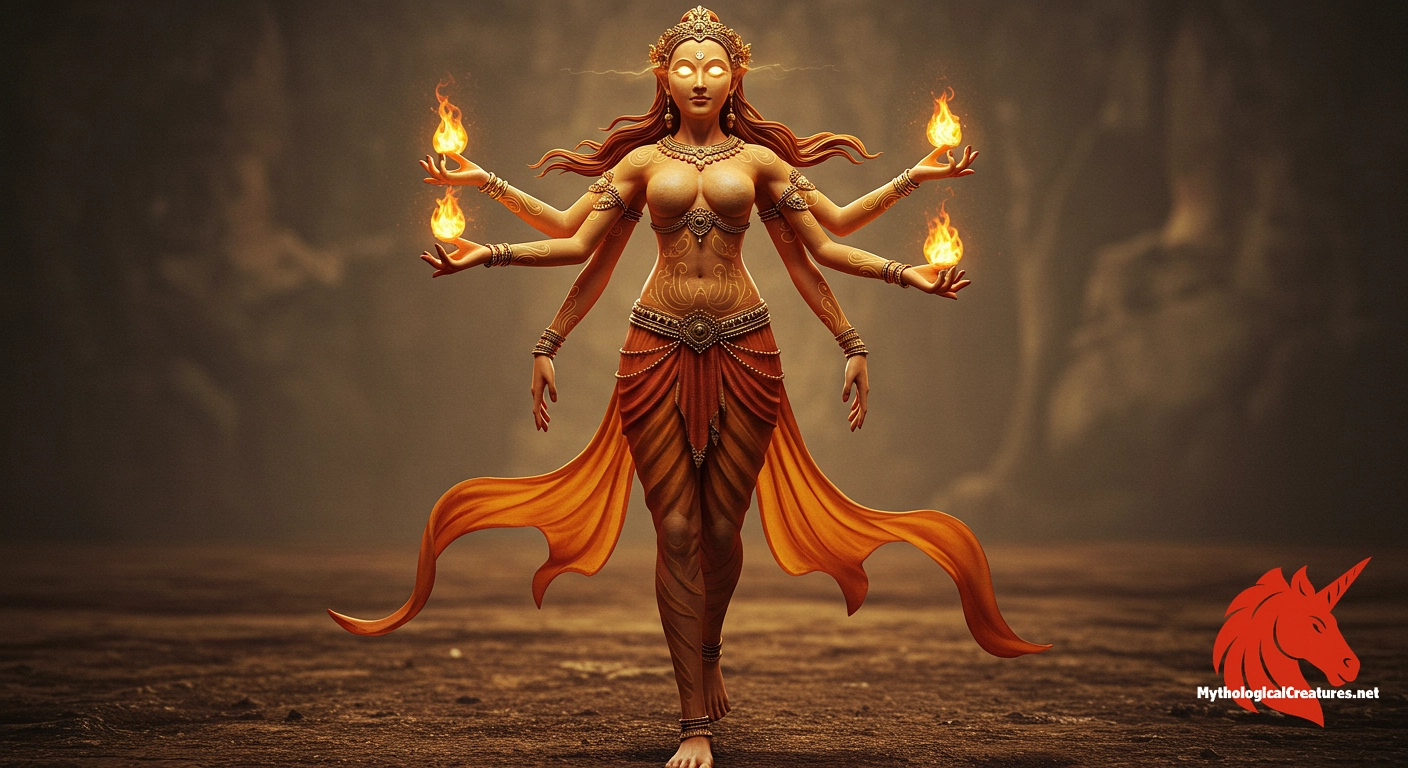Jwalamalini: Jwalamalini is a revered yakshini and guardian goddess in Jainism, serving as the divine protector of the eighth Tirthankara Chandraprabhu.

Jwalamalini
Jwalamalini - She is a prominent guardian deity in Jainism, especially revered in Karnataka for her role as the protector of Chandraprabhu, the eighth tirthankara.
Origins & First Encounters
Jwalamalini emerges as one of the most potent guardian deities within the Jain tradition, radiating a blend of fierce protection and nurturing benevolence. Her role as the yakshini of Chandraprabhu, the eighth tirthankara, places her at the heart of a sacred interplay between divine guardianship and spiritual guidance. Her earliest cultural witness lies in the early medieval period of Karnataka, where temple art and local practices celebrated her unique attributes. The intermingling of regional influences with Jain doctrinal purity along the centuries helped shape her character into a multifaceted deity. Her mythic origins appear to be forged in the crucible of local devotional fervour, resulting in a rich tapestry of iconographic symbols. The historical narrative surrounding her is steeped in a tradition that blends the transcendent with the familiar, inviting devotees to witness both the daunting and the compassionate sides of divinity. Devotional practices that venerate her have maintained an enduring legacy that speaks of protection, strength, and the transformative power of the sacred flame. In a cultural context that values dynamic expressions of divine energy, Jwalamalini continues to captivate and inspire worshippers even in contemporary times. Her enduring significance stands as a testament to the vitality of Jain spiritual expressions as they evolved amidst regional cultural landscapes.
Source Texts & Tale Variants
Ancient inscriptions and temple reliefs serve as the primary windows into the veneration of Jwalamalini, offering glimpses of her celebrated status among the faithful. Devotional narratives preserved in regional manuscripts and oral traditions reveal a constellation of stories that accentuate her divine intervention and protective might. Though dedicated literary texts focusing solely on her are relatively scarce, scattered references across Jain commentaries underscore her integral presence in ritualistic practices. In some early inscriptions, hints of her myth are woven into larger canvases that celebrate the accompanying tirthankara, thereby magnifying her role as a guardian. Creative interpretations passed down through generations continue to embellish her origins, sometimes describing her as emerging from an elemental spark that symbolises spiritual rebirth. Folk traditions and poetic recitations have enriched her mythos, incorporating dramatic accounts of her overcoming adverse forces. Later medieval texts, especially those emerging from Karnataka, further refine her image with a blend of regional artistry and ritual significance. Each narrative variant adds a layer to her mythological persona, creating a composite illustration that is both flexible and enduring. These diverse sources collectively highlight the dynamic process by which her story was transmitted, transformed, and immortalised in Jain devotional culture.
Form & Powers
Physical depictions of Jwalamalini are lavish and imbued with a symbolic elegance that draws the devotee into a realm of radiant mysticism. Her luminous complexion, reminiscent of a gentle yet fierce flame, speaks to her elemental connection with fire. The intensity of her eyes, often rendered as glowing embers, conveys both a piercing awareness and boundless compassion. Artistic portrayals frequently endow her with multiple arms, each hand delicately arranged to offer blessings, assert protection, or fend off malefic influences. Her attire is intricately designed, with motifs that echo the undulating, unpredictable dance of flames. A crown or halo fashioned in the imagery of fire commonly adorns her head, underscoring her luminous aura and divine energy. Sculptural representations capture her in dynamic poses that merge grace with resolute strength, ensuring that each gesture communicates both beauty and power. The blend of delicate jewellery and assertive postures in her iconography reflects her dual capacity as both benevolent guardian and formidable protector. Across variations in size and style, regional artisans have interpreted her form with imaginative creativity, ensuring that each rendition remains unique while upholding the core essence of her myth.
Regional Faces
The regional portrayal of Jwalamalini is a vibrant testament to the confluence of local artistry and widespread religious ideals. In Karnataka, where her worship once flourished, her iconography is marked by dramatic expressions that emphasise both her fierceness and nurturing attributes. Local craftsmen adapted her features to resonate with the cultural and symbolic lexicon of the region, interweaving local motifs with the doctrinal traditions of Jainism. In some parts of southern India, her representation is enhanced by elaborate floral and geometric patterns that evoke the natural world and its cycles of renewal. By contrast, neighboring traditions sometimes infuse her image with subtler, more flowing contours that reflect an inclusive spiritual ethos. Variations in her adornments and pose across regions reveal distinct local interpretations that blend indigenous legends with pan-Jain motifs. Community rituals and temple festivals have, over time, nurtured an environment for these adaptations, ensuring that her legend remains not only relevant but also richly diverse. Each regional iteration of Jwalamalini mirrors the broader cultural dialogues of its time, accentuating the fluidity inherent in myth-making. These adaptations collectively underscore how a singular divine figure can express multifaceted local identities while retaining a universal appeal.
Cultural Parallels
The figure of Jwalamalini resonates with other guardian deities across both Jain and broader South Asian mythological traditions. Her fiery attributes and protective mandate invite comparisons with Hindu goddesses whose iconographies similarly fuse the elements of ferocity and compassion, as seen in forms that echo the dynamic energy of Durga. In Buddhist art, deities such as Vajrayogini also encapsulate the delicate balance of beauty and formidable power, mirroring the dual aspects of Jwalamalini’s character. This cross-cultural linkage highlights a shared mythological motif where divine femininity is celebrated for both its aesthetic allure and its capacity to offer protection. The symbolic representation of fire, a recurrent element in various spiritual traditions, cements her connection with a universal imagery of purification and rebirth. Uniquely, her multi-armed depiction underscores a multiplicity of blessings and preventative grace, setting her apart as a complex goddess of both creativity and destruction. Echoes of her iconography can be found in regional folklore where divine protectress figures inspire local narratives and rituals alike. These interconnections across mythological traditions enrich our understanding of how deities serve as conduits between human aspirations and divine intervention, forging a tapestry of cultural unity amid diversity. Her illustrious presence thus becomes a bridge linking assorted spiritual traditions through the universal language of sacred fire and protective grace.
Legacy & Modern Evolution
Jwalamalini’s historical evolution reflects a journey through time marked by shifting artistic sensibilities and evolving devotional practices. Early medieval depictions in Karnataka are notable for their vivid portrayal of her as both a fierce warrior and a caring guardian, embodying the intense vitality of a sacred flame. Over successive generations, as spiritual narratives and regional artistic styles developed, her iconography absorbed new motifs while lovingly preserving her core attributes. Modern interpretations have reimagined her legacy, positioning her not only as an age-old protector but also as a symbol of resilience and transforming energy in contemporary spiritual discourse. In current temple festivals and cultural revivals, her imagery continues to invoke themes of protection, spiritual rebirth, and divine feminine power. The fluid evolution of her depictions reflects broader social and cultural changes, with modern devotees often appreciating her as a timeless emblem of empowerment and artistic excellence. Scholars and cultural enthusiasts have increasingly turned their attention to her myth as a dynamic expression of devotional art, revealing layers of historical significance and modern relevance. Through exhibitions, academic studies, and revivalist efforts, Jwalamalini’s presence endures as both an inspirational icon and a living narrative that bridges ancient tradition with the contemporary quest for meaning. Her celebrated legacy, rich in historical nuance and modern reinterpretation, ensures that her divine flame continues to illuminate the spiritual landscape for future generations.
Interesting Fact
An interesting fact about Jwalamalini is that her name, meaning 'flame garland', not only reflects her fiery attributes but also symbolizes the illuminating power of divine protection in the Jain tradition.
Quick Creature Info
Features:
Associations:
Our Mythic Legendary Rating:

Also Sometimes Known As:
Habitat:
Supernatural Powers:
Physical Attributes:
Abilities:
Behavior:
Lore:
References
Discover Another Mythical Legend You May Not Have Heard Of?
Uncover the mysteries of ancient folklore and expand your knowledge of legendary beings from cultures around the world.
Dare to Meet the Pureiromba....
Curated by the Mythological Creatures Team (rev. May 2025)
